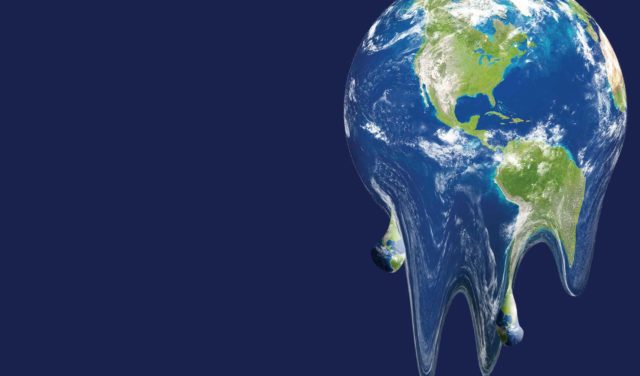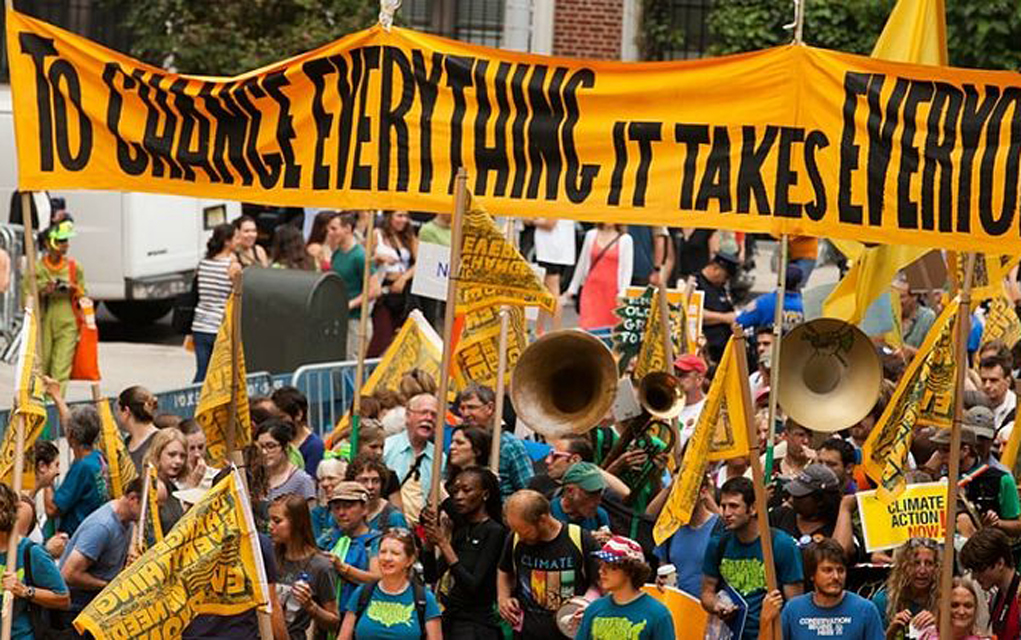
On April 22, millions of Americans will celebrate Earth Day, but this year will look a little different than the 46 others that came before. Alongside Earth Day’s traditional offerings like programs to stop deforestation, save endangered species and gatherings where people speak up for a planet that cannot speak for itself, hundreds of thousands of protesters will take to the streets this year — on April 22 for the March for Science and a week later for the People’s Climate Movement on April 29. Not since the first Earth Day have we seen such a public demand for change.
As scientist and author of The War on Science, Shawn Otto wrote in Scientific American in October 2016, the “emergence of ‘post-fact’ politics has normalized the denial of scientific evidence that conflicts with the political, religious or economic agendas of authority. Much of this denial centers, now somewhat predictably, around climate change — but not all. If there is a single factor to consider as a barometer that evokes all others in this election, it is the candidate’s attitudes toward science.”
As hundreds of thousands of scientists prepare to advocate on behalf of their discipline, they find themselves in an unfamiliar and precarious position. The scientific method seeks to explain the events of nature in a testable and reproducible way, which is to say that scientists are used to letting the facts speak for themselves.
“Many scientists tend to be somewhat introverted, cautious and not particularly interested in political actions of this type,” says Richard Anthes, president emeritus of UCAR and former president of the American Meteorological Society. “That they are speaking up now, and in such number, I think shows the high level of concern about the future of science in the U.S.”
Tensions came to a head when, just weeks after Donald Trump took office, his administration began instructing employees in the Environmental Protection Agency and the Departments of Agricultural and Interior to cease communicating with the general public, issuing a gag order of sorts.
Online, people immediately expressed their discontent and, somewhere deep in a thread on reddit, username beaverteeth92 wrote: “There needs to be a Scientists’ March on Washington.”
“100 percent,” another user replied.
University of Texas Health Science Center postdoctoral fellow Jonathan Berman took the idea seriously, or at least seriously enough to start a Facebook page calling for a March for Science on the mall in Washington D.C. In less than 24 hours, 300,000 people expressed interest.
Among those was Denver activist Eric Keitzner, who lay awake in what was one of many sleepless nights following Trump’s inauguration. He saw the March for Science as a call to action he could not ignore.
He felt ready to commit to organizing what would become the satellite march in Denver, to mobilize 20,000 people in just two months. The idea settled into reality as he was lying next to his wife in bed. She looked at him and asked if he was sure he wanted to make the commitment.
“Positive,” he replied. For Keitzner, it’s not just about the big picture, it’s personal — the funding for his wife’s job in family planning is at risk under the new administration. Right then and there, he started a Facebook page for a Denver satellite march and the next morning 1,500 people had signed up.
Richard Anthes didn’t hesitate to join in the action either.
Anthes has a legacy of intermingling science with Earth Day activities. In 1995, as president at UCAR in Boulder, he worked to create public events at the city’s many government funded scientific institutions. Back then he told the Daily Camera it was important scientists take an active role in doing what they could to “increase the scientific literacy of the general public” in an effort to instill an environmental consciousness.
Since then, he says we have made a lot of progress, not just since 1995, but since Earth Day was instituted in 1970. He cites early victories like removing asbestos from buildings and lead from paint as examples. He describes how we were gaining optimism for how science might help to tackle even bigger, more complex problems like climate change — “were” being the operative word. Now all that he and his peers in the scientific community have worked for is being threatened not only by the Trump administration’s lack of belief in science but also by massive budget cuts of up to 30 percent at institutions like the National Oceanic and Atmospheric Administration and the National Renewable Energy lab.
“This could have a huge impact, not just on the environment, but on the local economy in Boulder and across Colorado, which depends on the federal government to fund its universities and government labs,” he says.
He reminisces about a time when science wasn’t a contentious issue for political debate, but simply a pursuit of enlightenment, a curiosity about the world around us.

Humans, he says, are prone to think and wonder about the natural world, about phenomena like “why the moon rises and sets, why the tides pull, why the seasons change and why the winds blow the way they do. We wonder why storms form and die.”
“Everything about the environment is associated with a complex set of biological and physical mechanisms,” Anthes says. “For a long time, people didn’t understand those things so they made up stories to explain the unknowns. But gradually, as science became learned and relearned through the generations, we started unraveling many secrets of the world — weather and the climate and the biological cycles and evolution and the list goes on.”
Despite our predisposition for scientific pursuits, science hasn’t always been interwoven with government as it has been in the modern era. Since World War I, government has played an increasingly important role in everything from national security to environmental policy to research, development and technology. Anthes says countries that invest in science become great, and the others? “Losers,” he says with a knowing laugh.
Today though, science is up for political debate. Hillary Clinton received some of her largest cheers for declaring “I believe in science!” in her speech at the Democratic National Convention. Meanwhile, Donald Trump tweeted that “the concept of global warming was created by and for the Chinese in order to make U.S. manufacturing non-competitive,” getting more than 100,000 re-tweets and 67,000 likes.
Anthes can’t believe it. “It’s actually crazy,” he says. “None of this should be necessary. Why do we have a march for science? Why do we have a march for truth? It shouldn’t be necessary to waste people’s time and money by marching or protesting the value of science.
“Just like,” he pauses, apologizing for the political views he was about to offer up, “Nevermind, because you know what? These views are actually scientifically based, too. You shouldn’t have to have marches for freedom or equality, or against racism or marches for women.”
The March for Science is a part of a renaissance of marches proliferating across the country, most notably the Women’s March, which arguably sparked the idea for the March for Science and certainly created the momentum for such actions. The Women’s March brought more than 485,000 protesters to D.C. and 3.2 million to rallies around the world in the weekend following Trump’s inauguration.
Speaking about the broader context of protests in the current political climate, Lisa Cutter, organizer of the March on Colorado (formerly the Women’s March on Denver), explains the massive turnout and ongoing movement as the result of finally breaking through what she calls “years of suppression.”
She says that on the individual level, women tend to brush incidences of harassment or unequal pay under the rug, “dismissing them as little things, because they don’t seem terribly traumatic.” But as the Women’s March gained momentum, women across the world realized they weren’t alone and that the transgressions they suffered as individuals added up to an epidemic of international proportions.
“This is not so different from climate change,” Cutter adds. “The little things, like decreased annual snowpack in the Rockies or more tornadoes in the south, one-by-one they might be easy to ignore, but when you add it all up, it’s dire, too.”
To offer the big picture narrative on climate change, the People’s Climate Movement is revving back up for a day of global protest on April 29, including in Denver. It’s the next iteration of the September 2014 People’s Climate March on the eve of the United Nation’s Climate Summit. That effort resulted in the largest march for the climate in history thus far. Since then, the organization has taken a hiatus from massive marches, opting instead for teach-ins, youth education and localized actions.
Back then, activist Bill Mckibben issued the call for the march as “an invitation to change everything,” in hopes that the environmental movement could find an identity in the age of climate change. Global warming presented a big and amorphous problem, one that affected everyone, but in many diverse ways. To rally global momentum to address the complex mechanisms at play, McKibben knew the movement needed a face, but he also knew that just one spokesperson wouldn’t do. They needed to find 600,000 faces from all around the world. The potential was there, the problem was how to seed the cloud.
By many accounts, the march was a success, catalyzing the creation of the most concrete and significant global climate policies ever put forward by the U.N. In part, this success was attributed to the apolitical nature of the protests that left behind party politics in order to focus on humanity itself.
On the contrary, the 2017 People’s Climate Movement march is driven by pointed politicism aimed squarely at the Trump administration and its anti-environmental rhetoric and actions — specifically against such policies as the March 27 executive order that begins to repeal the Clean Power Plan and other environmental protections.

The Movement’s messaging is clearly pointed at Trump and the rhetoric is ripe with war-like language, as in this statement on peoplesclimate.org:
“Everything we have struggled to move forward in the United States is in peril. Our loved ones feel under siege, and those in power in Washington are advancing a dark and dangerous vision of America that we know is untrue. To change everything, we need everyone.”
Jackie Vail, one of five organizers of the Denver Climate March, says she is fighting like her life depends on it, “because it does.” And on April 29, she expects to be joined by up to 20,000 Coloradans who feel the same sense of desperation.
Vail offers emotional anecdotes about trying to get through to her conservative family, or about her trips to coastal Haiti already ravaged by rising sea waters. “It might not be a good thing,” she says, “but I tend to think with my heart.” She imagines that many marchers will be driven by similarly personal experiences.
Sometimes, emotion is an important part of political action. After all, as Mckibben wrote in his original call to march printed in The New Yorker in 2014, “In a rational world, no one would need to march.”
But sometimes, Richard Anthes says, emotion can cloud our judgment. “No matter what your political leanings, belief and prejudice can get so strong that they block your rational thinking and you are just unwilling to accept scientific evidence that goes against your cultural or your religious beliefs. On the right, this could be denial of global warming and on the left, the disposition that GMOs are a bad thing, for example.”
But while science may be immune from moral and emotional persuasion, scientists themselves are not. While the March for Science has drawn support from prominent scientists around the country, some are worried that the March for Science is inappropriate and may send the wrong message about the ethics of the profession.
Physicist Sylvester James Gates warned that “such a politically charged event might send a message to the public that scientists are driven by ideology more than by evidence.” And, writing in the New York Times, geologist Robert S. Young argues that the march will “reinforce the narrative from skeptical conservatives that scientists are an interest group and politicize their data, research and findings for their own ends.”
Denver organizer of the March for Science Eric Keitzner says that while he tends to agree that could happen (and in some sense has already happened), there is simply no time left to delay or waver in taking action.
“Make no mistake, this march popped up in direct opposition to the gag orders on the EPA, on the National Park Service and on the silencing of the scientific community at large,” he says. “Our intention is to have direct impacts on policy makers by advocating for evidence-based policy and fact-based decision making.”














